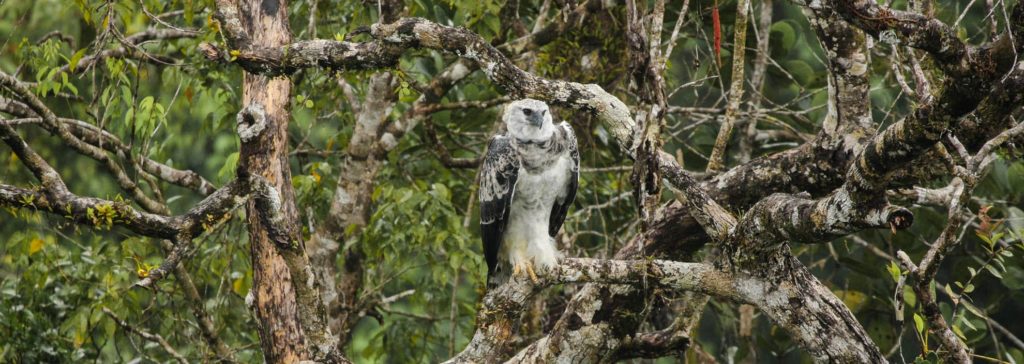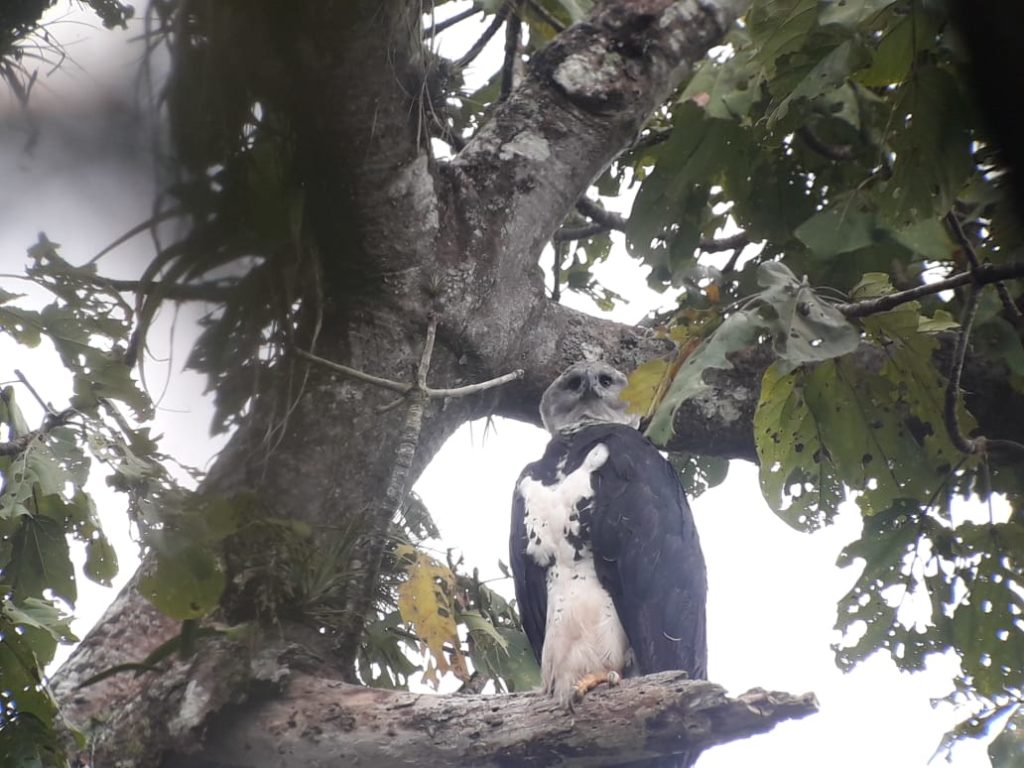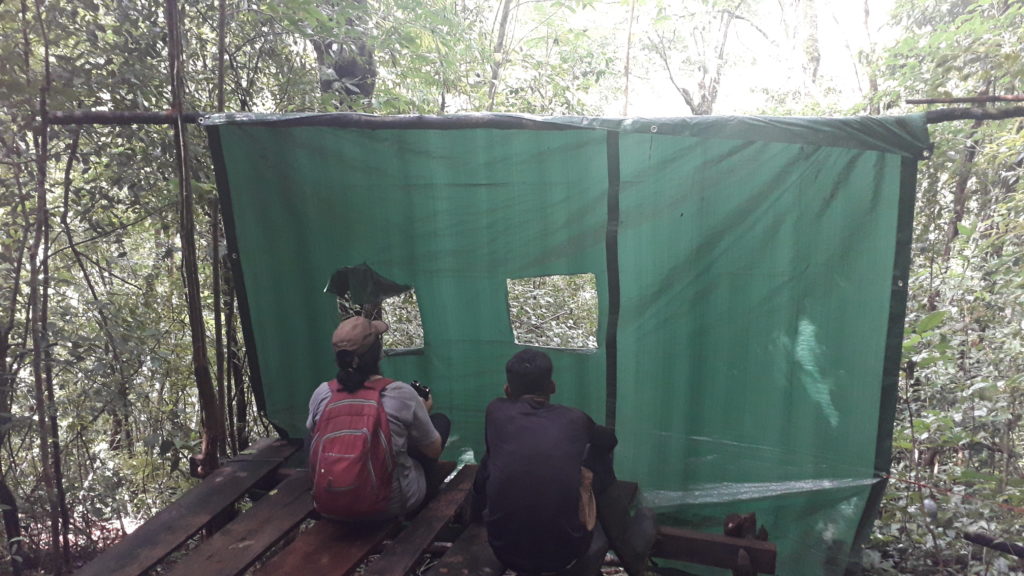
Why Harpy Eagles
We could think of no better bird to start off our monthly “Bird in Focus” blog series than the Harpy Eagle. Not only is it the National Bird of Panama, where our headquarters are located. But, nearly of all our team members have worked on The Peregrine Fund’s Harpy Eagle conservation project at one point or another in their careers. Harpy Eagles brought us together and they hold a special place in our hearts.
Collectively, we have had some amazing experiences working with these birds. We have climbed into Harpy Eagle nests (which are built in emergent trees high above the canopy) to band young nestlings. We have spent days bushwhacking through Panama’s lowland rainforests, tracking released Harpy Eagles in Soberania National Park, we have felt the heartbreak of finding an eagle killed by poachers, and the joy of seeing a young bird fly for the very first time. Intelligent, curious, sometimes comical (with their lopsided crests), and often fierce, the Harpy Eagle is a true force of nature.
Some Harpy Eagle Fun Facts
- The Harpy Eagle was officially declared Panama’s National Bird on April 10, 2002. Every year we celebrate Harpy Eagle Day on this date.
- As with almost all birds of prey, the females are much larger than the males.
- The rear talon of a female Harpy Eagle can be bigger than a grizzly bear’s claw.
- Harpy Eagles are monogamous, and pairs can remain together for several decades.
- Harpy Eagles, like many owls and harriers, have a facial disk. They can lift and lower the feathers on their face and crest to help direct sound to their ears.
- They feed on medium-sized arboreal animals such as monkeys, sloths, opossums, birds, and more.
- Though their historic range is from southern Mexico to northern Argentina, Panama is the only country in Central America with a known breeding population.
- The Harpy Eagle’s scientific name is Harpia harpyja.
- Its conservation status is Vulnerable.
- Though they can lay up to two eggs, science has only documented one successful fledgling per nest. Harpy Eagles don’t engage in siblicide (where the bigger, stronger nestling kills its weaker, smaller sibling). Rather, the female will stop incubating once the first of the two eggs hatch.
- Young birds fledge at 6 months of age but can remain in their parents’ territory for two years or more. Normally, a pair of Harpy Eagles won’t nest again until the juvenile disperses from the area.
Where and When to see Harpy Eagles

Darien, in eastern Panama, is one of the best places to see these magnificent birds in the wild. Harpy Eagle sightings can occur year-round. However, January through May are usually good months. This is when the young birds are still in or near the nest, making spotting them much easier.
Though known for its pristine rainforests and high biodiversity, Darien province is a mosaic of healthy and degraded forests, teak farms, rivers, mangroves, farmlands, fishing villages, bustling towns, and more. Located about 5-6 hours from Panama City by car, Darien has the densest known population of Harpy Eagles in Central America. The journey to see a Harpy Eagle starts with an overnight stay in Meteti, the main town in Darien that has a mixture of local hotels, general stores, local restaurants, and even a discotheque or two. Located less than an hour from the end of the Pan-American Highway, Meteti is the starting point for most visits to see a Harpy Eagle.
The next morning, we typically get an early start. The day’s journey is usually long and requires a mix of driving, riding in a dug-out canoe up a river, and a hike through farm fields, forest, or a mixture of both! Once there, we get comfortable and wait. We are accompanied by guides from the local communities who will help us spot the eagles if they are not in the nest. If we get lucky, we may observe one or more of these amazing birds flying, preening, feeding, or otherwise just hanging out on a branch high up in the canopy.
We will then backtrack and slowly make our way back to Meteti where we will spend another night. Along the way, and depending on the exact location of the nest, we will likely see a few other species. Some highlights include Gray-cheeked Nunlet, Black Oropendola, and Golden-headed Manakin. Mammals such as Mantled Howler Monkeys, White-faced Capuchins, and Coatimundis might also be seen along the way, and so much more.
Helping to Conserve Harpy Eagles

We work closely with Fundacion Rapaces y Bosques, a partner of The Peregrine Fund. They are collaborating to carry out one of the longest studies on Harpy Eagles ever – more than 20 years so far!
When we visit nests, we employ local staff as guides, porters, cooks, and more. This helps to bring economic revenue into communities that is directly related to protecting and preserving the Harpy Eagle.
For the well-being of the birds, we do not visit Harpy or Crested Eagle nests when they are in the courtship, nest-building, and incubation stages. We also avoid visiting nests within the first few weeks after hatching. With the popularity of these birds, high human traffic to nest sites during these sensitive stages can easily cause undue stress on the birds and cause them to abandon the nest site. We avoid this at all costs. We also refrain from sharing the exact location of nests to avoid revealing sensitive information that could put these birds at risk.
To learn more about how to conserve Harpy Eagles in the wild, or to help protect them, please consider donating to The Peregrine Fund. You can also make a donation through Whitehawk. Your donation will go directly to Fundacion Rapaces y Bosques and their reforestation project.

Would you like to schedule a tour or learn more about how to see Harpy Eagles in the wild? Please contact us at info@whitehawkbirding.com

